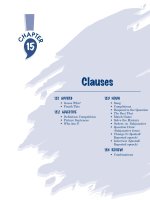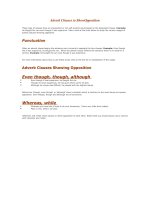UEfAP clauses
Bạn đang xem bản rút gọn của tài liệu. Xem và tải ngay bản đầy đủ của tài liệu tại đây (74 KB, 2 trang )
UEfAP Clauses
Grammar in EAP
Clauses, Simple Sentences & Clauses Complexes
Elements of the clause
A clause or a simple sentence consists of two elements.
Subject
Predicate
The participants
were chosen.
Jones
investigated the issue secretly in the early 1950s.
All finite clauses require a subject and a predicate. The predicate consits of several other elements,
some are essential and some are optional. The description of the structure of the clause uses four
main elements: subject (S), predicator (P), complement (C) and adjunct (A).
For example:
S
P
C
A
A
Jones
investigated
the issue
secretly
in the early 1950s.
Subordination & Coordination
A simple sentence consists basically of one independent clause. For example:
"The idea of a National Government had implanted itself in the mind of the King."
Clauses can be combined to form clause complexes. There are two main ways in whcih clauses can
be combined.
Combining Clauses
Clauses can also combine to form complex or compound sentences.
Realisation of Clause Elements
These elements of clause stucture are realised by various word, groups or clauses. In English there is
no onetoone correspondence between class of unit (noun, verb, nominal group, finite clause, ...) and
syntactic function (subject, predicator, complement, adjunct). See: Grammar: Realisation of Clause
Elements









